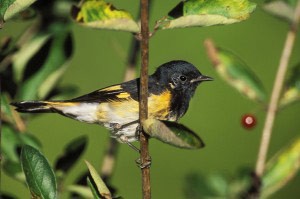
Scientists have recently found that, when it comes to making offspring, American redstarts have good years and bad years. More specifically, a good year will likely be followed by a bad year, and vice versa. The reason is because of tradeoffs between energy-intensive activities, some of which help a redstart be a better parent and others that help the redstart compete with other redstarts – like setting up a college savings account for your kid versus buying that new convertible.
These tradeoffs include when to reproduce, when to molt, or shed summer feathers, and when to migrate. The timing and duration of each directly affects the timing, duration, and success of the others. The successful bird is the one that can perform a delicate balancing act over its lifetime between ensuring its own survival and the survival of its young, according to a new study in the journal Science by D. Ryan Norris and his colleagues at Queen’s University in Ontario.
Norris’s team examined feathers from male redstarts during the breeding season in Ontario. The research team had developed a technique to accurately determine where, on the migration route to tropical wintering grounds the previous autumn, the redstarts had molted their summer feathers. They found that 40 percent of the males molted at staging areas – spots along the route where the birds stop to regroup – which can be up to 1,200 miles away from where they breed.
Male redstarts are normally monogamous fathers, and they help their mates care for their young. The scientists wondered whether the latitude at which redstarts molted was at all related to how well and how long males cared for their young. They found that males with the most and healthiest young tended to molt farther south during the autumn following breeding. Males who failed at raising young were most likely to molt right at the breeding grounds.
But, the scientists note, molting during migration takes time and could delay the arrival of successful breeders to wintering areas; latecomers would have to settle with leftover, lower-quality habitat, which could negatively affect their physical condition and thus their arrival time at the breeding grounds the next spring. Latecomers to the breeding grounds would lose out on choice breeding habitat and mates, and they would be less successful parents that particular year.
Also, successful male parents (who thus molted during migration) had feathers with lower color quality, most likely a result of the stress of molting while migrating. But because females prefer brightly colored males, they are less inclined to choose the dull-feathered males who’d proven themselves as successful parents the previous year; these tradeoffs suggest that redstarts raise successful offspring and optimize their own fitness on an every-other-year cycle.

